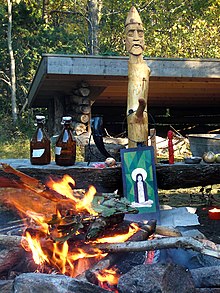
Back صنم Arabic Büt Azerbaijani Ідал Byelorussian পূজ্য প্রতিমূর্তি Bengali/Bangla Ídol Catalan Modla Czech Bùwrón (idol) CSB Idol (gudebillede) Danish Idol German İdol DIQ



In the practice of religion, a cult image is a human-made object that is venerated or worshipped for the deity, spirit or daemon that it embodies or represents. In several traditions, including the ancient religions of Egypt, Greece and Rome, and Hinduism, cult images in a temple may undergo a daily routine of being washed, dressed, and having food left for them. Processions outside the temple on special feast days are often a feature. Religious images cover a wider range of all types of images made with a religious purpose, subject, or connection. In many contexts "cult image" specifically means the most important image in a temple, kept in an inner space, as opposed to what may be many other images decorating the temple.
The term idol is an image or representation of a god used as an object of worship,[1][2][3] while idolatry is the worship of an "idol" as though it were God.[4][5][6]
- ^ "idol". American Heritage Dictionary. 2016. Retrieved 2019-01-29.
- ^ "idol". Merriam–Webster. 2019-01-15. Retrieved 2019-01-29.
- ^ "idol". Oxford Living Dictionaries. 2017. Archived from the original on 2016-09-30.
- ^ Moshe Halbertal; Avishai Margalit; Naomi Goldblum (1992). Idolatry. Harvard University Press. pp. 1–8, 85–86, 146–148. ISBN 978-0-674-44313-6.
- ^ DiBernardo, Sabatino (2008). "American Idol(atry): A Religious Profanation". The Journal of Religion and Popular Culture. 19 (1): 1–2. doi:10.3138/jrpc.19.1.001., Quote: "Idolatry (...) in the first commandment denotes the notion of worship, adoration, or reverence of an image of God."
- ^ Poorthuis, Marcel (2007). "6. Idolatry and the Mirror: Iconoclasm as a Prerequisite for Inter-Human Relations". Iconoclasm and Iconoclash. BRILL Academic. pp. 125–140. doi:10.1163/ej.9789004161955.i-538.53. ISBN 9789004161955.